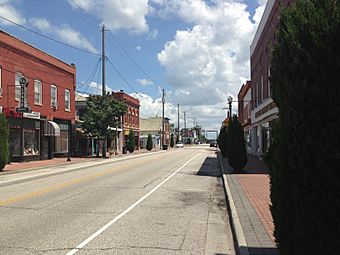Phoebus, Virginia facts for kids
|
Phoebus Historic District
|
|

Historic Phoebus in 2013, viewed from East Mellen Street
|
|
| Location | Roughly bounded by VA 64, Mallory St., E. County St. and Willard Ave., Hampton, Virginia |
|---|---|
| Area | 86 acres (35 ha) |
| Built | 1874 |
| Architect | Holtzclaw, Charles Taylor; Wenderoth, Oscar |
| Architectural style | Late Victorian, Late 19th And 20th Century Revivals |
| NRHP reference No. | 06001098 |
Quick facts for kids Significant dates |
|
| Added to NRHP | December 1, 2006 |
Phoebus is a historic neighborhood in the city of Hampton, Virginia. It was once a separate town, known as Chesapeake City from 1871 to 1899. In 1900, it was renamed Phoebus to honor Harrison Phoebus, a local businessman. He helped convince the Chesapeake and Ohio Railway (C&O) to extend its train tracks to the town.
In 1952, Phoebus became part of Hampton after a public vote. Today, Phoebus is a very important historic area in Hampton. It is even listed on the National Register of Historic Places, which recognizes special historic places in the United States.
Contents
History of Phoebus
Early Beginnings
In 1607, Captain John Smith landed on a spot in Phoebus called Strawberry Banks. This happened during his first trip up the James River. The area that became Phoebus was first settled in 1609 and was called Mill Creek. It was located right on the Chesapeake Bay and Hampton Roads.
In 1619, the Virginia Company of London divided the developed areas of the colony into four "citties." Mill Creek was part of Elizabeth Cittie. Later, in 1634, the area became part of Elizabeth City Shire, one of Virginia's first eight shires. It was renamed Elizabeth City County in 1643.
Fort Monroe and the Civil War
English colonists built forts at Old Point Comfort to protect the entrance to Hampton Roads. In 1819, the U.S. Army started building Fort Monroe there. Until 2011, it was the oldest active-duty fort in the country.
During the American Civil War, many enslaved people escaped to Fort Monroe. Union forces occupied nearby Norfolk from 1861. The U.S. Army called the escaped enslaved people "contraband." This meant they would not be returned to their enslavers. Facilities were set up for these newly freed people at the Fort Monroe Contraband Camp.
Officials asked Mary S. Peake, a respected local teacher, to teach the freed people and their children. She started her lessons outdoors in Phoebus, under a large oak tree. In 1863, the Emancipation Proclamation was read to many citizens under this tree. It became known as the Emancipation Oak. The American Missionary Association (AMA) hired her to teach. They also provided her with a building called the Brown Cottage. This is seen as the beginning of Hampton University, a college founded during the war for African Americans.
From Farm to Town
Much of the Phoebus area was a farm called Roseland Farm until 1871. Then, the land was divided into lots and sold. This is how Chesapeake City began. The streets were named after important local people, like Mallory, Curry, Hope, Lancer, and Mellen.
When the town officially became a town in 1900, its name changed to Phoebus. This honored Harrison Phoebus, who was key in getting the Chesapeake and Ohio Railway (C&O) to build a train line to the area. After the railroad reached Newport News in 1881, the same crews extended the tracks towards Fort Monroe. The tracks reached Phoebus in December 1882. A train station opened, and the railroad named it "Phoebus."
Extending the tracks from Phoebus to Fort Monroe required a very long bridge over Mill Creek. This bridge was finished in 1890. At that time, more facilities for passengers and freight were added at Fort Monroe. The U.S. Army even built its own tracks and used its own train there for many years. The Fort Monroe station closed in 1939. Because of this, Phoebus became the starting point for C&O trains heading west, like the Sportsman and the George Washington.
At Old Point Comfort, the train line served Fort Monroe. It also connected to popular hotels like the older Hygeia Hotel and the newer Hotel Chamberlin. These were favorite spots for visitors. In the early 1900s, special trains ran to Buckroe Beach. This beach had an amusement park and other fun attractions for church groups and people on vacation.
Recent Decades
In 1952, the people of Elizabeth City County and the town of Phoebus voted to join with the independent city of Hampton, Virginia.
Between 1953 and 1954, the C&O railroad stopped using Phoebus as the final stop for its passenger trains. The trains, including the George Washington and the Sportsman, then ended their journeys at the Newport News station.
Today, Phoebus has a special area listed as a historic district on the National Register of Historic Places. The Phoebus National Historic District covers about 86 acres. It includes the historic business area on Mellen and Mallory Streets, along with many historic homes.
Notable People from Phoebus
- Ralph Wolfe Cowan (1931–2018), a famous artist.
- John William "Uncle Jack" Dey (1912–1978), a well-known folk painter.
- Christopher C. Kraft Jr. (1924–2019), the first Flight Director for NASA, who grew up in Phoebus.
- Mary S. Peake (1823–1862), the first teacher for freed enslaved people and their children in Phoebus.
- William T. Randall, (1915–2013), a baseball player in the Negro league.
- George R. E. Shell, (1908–1996), a Brigadier General in the United States Marine Corps and the ninth superintendent of Virginia Military Institute.



